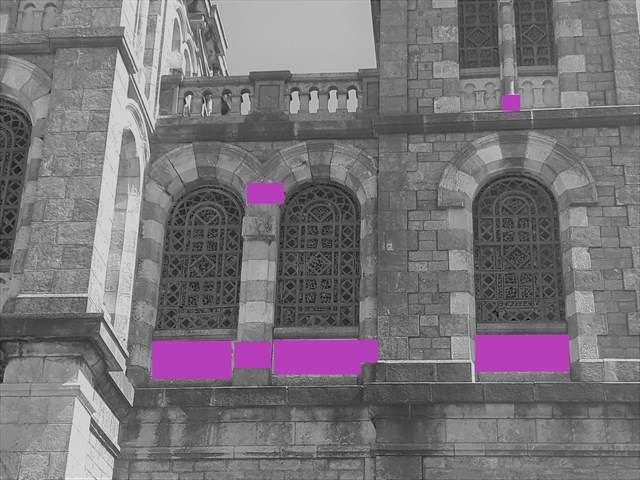1) Lessivage et dissolution
1) Leaching and dissolution
L’effet combiné de la dissolution chimique et de l’action érosive provoquée par le lessivage des eaux de pluies émousse les reliefs et fait disparaître les formes, les zones exposées sont plus claires. Les visages et les mains des statues sont lissés. Une usure différentielle peut aussi creuser les parties tendres et accentuer les parties dures, créant une surface alvéolaire :
The combined effect of chemical dissolution and erosive action caused by the leaching of rainwater dulls the reliefs and makes the shapes disappear, the exposed areas are lighter. The faces and hands of the statues are smoothed out. Differential wear can also hollow out the soft parts and accentuate the hard parts, creating a honeycomb surface :
2) Encroutement et colonisation par les végétaux
2) Encrustation and colonization by plants
Les zones humides abritées sont propices à la colonisation par les végétaux (mousses, lichens). Des particules atmosphériques peuvent aussi s’agglomérer et conduire à la formation d’une croûte noire. Elles sont majoritairement constituées de gypse, de sulfates, de particules d’hydrocarbures, de goudron et de poussières. Elles peuvent aussi être constituées de calcite recouvrant la pierre d’une patine ocre.
Sheltered wetlands are conducive to colonization by plants (mosses, lichens). Airborne particles can also clump together and lead to the formation of a black crust. They are mainly made up of gypsum, sulphates, hydrocarbon particles, tar and dust. They can also be made of calcite covering the stone with an ocher patina.
3) Desquamation et détachement en plaques
3) Desquamation and detachment in plates
Cette dégradation correspond à un écaillage en mille-feuilles de la surface du calcaire qui se décolle progressivement de la paroi souvent dû à des écarts de température et aux cycles gel-dégel et à la présence de sels. La roche devient très friable et se fragmente en plaques.
This degradation corresponds to a flaking in mille-feuilles of the surface of the limestone which gradually peels away from the wall, often due to temperature differences and to freeze-thaw cycles and to the presence of salts. The rock becomes very friable and breaks up into plates.
Questions pour valider cette earthcache :
D'après vos observations et à l'aide du descriptif :
Questions to validate this earthcache:
Based on your observations and using the description :
Question 0
Joindre à votre log (PAS à vos réponses) une photo de votre GPS, votre GC perso ou tout autre objet de geocaching aux coordonnées de la cache (sans montrer les réponses !).
Les photos de l'Eglise seule ou capture d'écran de votre position ne permettent de valider cette condition de log.
Cette tâche est obligatoire et autorisée par les guidelines mises à jour en juin 2019.
Attach to your log (NOT to your answers) a photo of your GPS, your personal GC or any other geocaching object at the posted coordinates (without showing the answers !).
The simple photos of the church or screenshot of your position do not validate this log condition.
This task is mandatory and allowed by the guidelines updated in june 2019.
Question 1
Au dessus de l'entrée principale / Above the main entrance
A l'aide des photos des roches en index, identifier les roches de chacune des zones rouges, vertes, bleues et jaunes ?
With the help of the index photos, identify the type of rock in each areas red, green, blue and yellow.
Question 2
Aile droite / Right Wing

a. Quel(s) types(s) d'altération pouvez-vous observer dans les zones violettes ?
b. Expliquez quels en sont selon vous les agents responsables ?
a. What type (s) of alteration can you observe in the purple areas ?
b. Explain which agents do you think are responsible ?
Question 3
Quelle roche présente la forme d'altération la plus marquée ? Comment l'expliquez-vous ?
Which rock has the most marked form of weathering ? How do you explain it ?
Envoyez-moi vos propositions de réponses soit via mon profil, soit via la messagerie geocaching.com (Message Center) PUIS loguez cette cache "Found it", je vous contacterai en cas de problème.
Assurez vous de répondre à TOUTES les questions ! La condition principale pour loguer une Earthcache étant de répondre aux questions posées dans le descriptif, tout log "Found it" enregistré sans envoi préalable de vos propositions de réponses sera supprimé. Il en sera de même pour les logs enregistrés sans la photo requise.
Send me your proposals for answers either via my profile or via the geocaching.com messaging (Message Center) THEN log this cache "Found it", I will contact you in case of problem.
Make sure to answer ALL questions ! The main condition to log an Earthcache is to answer the questions asked in the description, any log "Found it" registered without prior submission of your proposals of answers will be deleted. It will be the same for logs saved without the required photo.